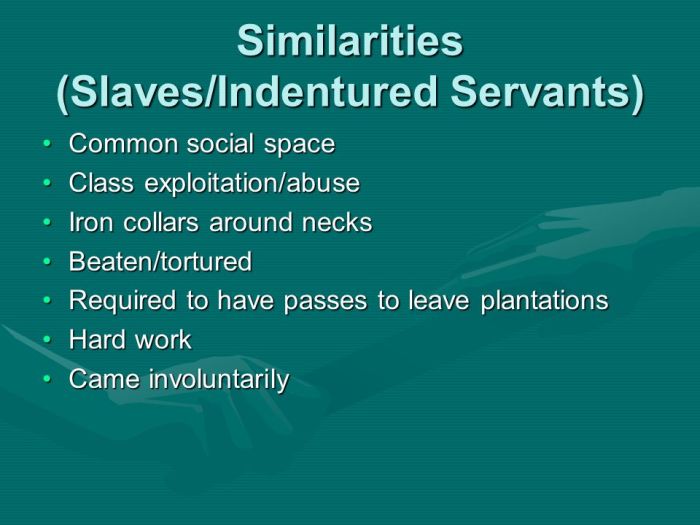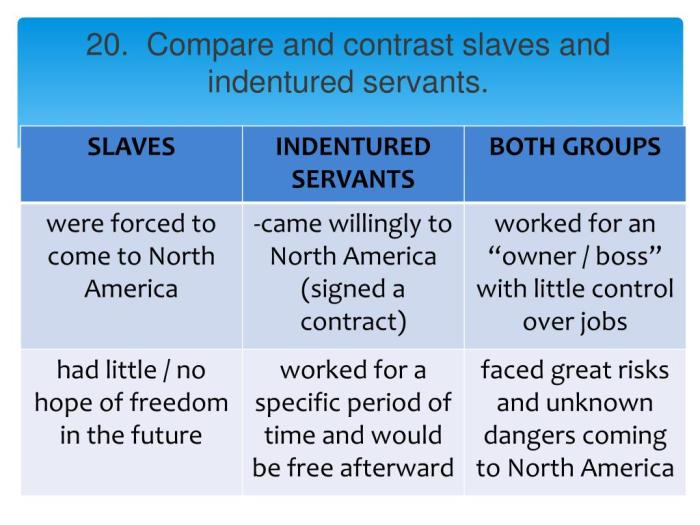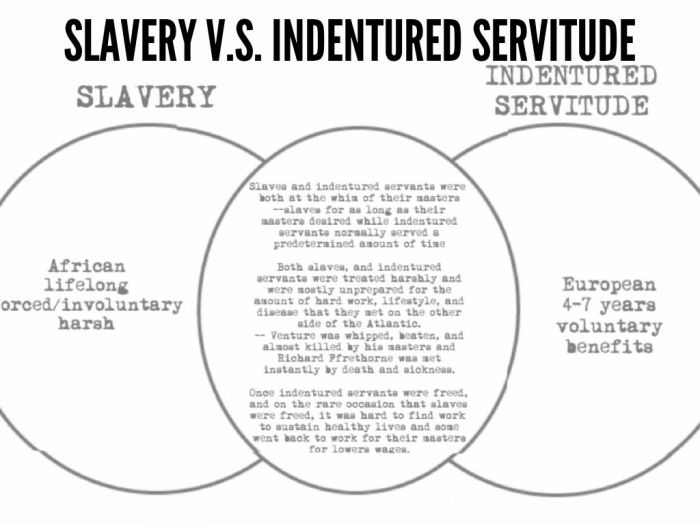Similarities between indentured servants and slaves have long been a subject of historical inquiry, shedding light on the complexities of labor and social hierarchies in colonial societies. This essay delves into the contractual differences, labor conditions, living arrangements, social status, legal protections, economic impact, cultural influences, and abolition of these two distinct yet interconnected groups, offering a comprehensive analysis of their shared experiences.
Similarities Between Indentured Servants and Slaves

Contractual Differences
Indentured servants and slaves were bound to their masters by legal agreements, but the terms and conditions varied significantly. Indentured servants entered into contracts for a fixed period, typically 4-7 years, after which they gained their freedom. Slaves, on the other hand, were considered property and had no legal rights or freedom.
They could be bought, sold, or inherited, and their servitude was lifelong.
Labor Conditions
Indentured servants and slaves both performed manual labor, but the severity and duration of their work differed. Indentured servants typically worked 10-12 hours per day, six days a week, and were assigned a variety of tasks, such as farming, construction, and domestic work.
Slaves, however, faced harsher conditions, working 12-14 hours per day, seven days a week, and were often subjected to brutal punishments for disobedience or poor performance.
Living Conditions
Indentured servants and slaves lived in different conditions, reflecting their legal status. Indentured servants often shared housing with other servants or their masters’ families, while slaves lived in separate quarters, often in crowded and unsanitary conditions. Indentured servants received basic food, clothing, and shelter, while slaves were often given only the bare minimum necessary for survival.
Social Status, Similarities between indentured servants and slaves
Indentured servants and slaves had low social status, but indentured servants had some limited rights and privileges that slaves did not. Indentured servants could marry, own property, and earn wages after their term of service was complete. Slaves, on the other hand, were considered property and had no legal rights.
They could not marry, own property, or testify in court.
Legal Protections
Indentured servants and slaves had different levels of legal protection. Indentured servants were protected by the terms of their contracts and could seek legal recourse if their masters violated them. Slaves, however, had no legal rights and were subject to the absolute authority of their masters.
They could be punished or even killed without any legal consequences.
Economic Impact
Indentured servitude and slavery played significant roles in the economic development of colonial societies. Indentured servants provided a source of cheap labor for a variety of industries, while slaves were the backbone of the plantation economy in the American South.
Both systems contributed to the economic growth and prosperity of these societies.
Cultural Influences
Indentured servants and slaves brought their own cultural traditions and customs to the colonies, which influenced the social and cultural landscape of these societies. Indentured servants often blended their traditions with those of their masters, while slaves developed their own unique cultural identity that reflected their African roots and their experiences in the New World.
Abolition and Legacy
Indentured servitude and slavery were eventually abolished in most Western societies, due to a growing movement for human rights and social justice. The abolition of these systems had a profound impact on society and race relations, and the legacy of these systems continues to be debated and discussed today.
General Inquiries: Similarities Between Indentured Servants And Slaves
What were the key contractual differences between indentured servants and slaves?
Indentured servants entered into a legal agreement for a fixed period, while slaves were considered property and had no legal rights.
How did the labor conditions of indentured servants compare to those of slaves?
Indentured servants typically worked under harsh conditions, but their labor was usually limited to a specific period, while slaves were subjected to lifelong servitude.
What were the similarities in the living conditions of indentured servants and slaves?
Both groups often lived in cramped and unsanitary conditions, with limited access to basic necessities.

